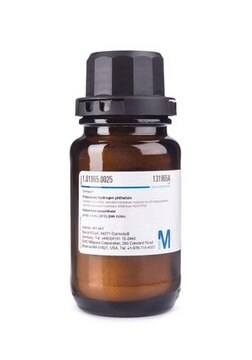P1088
Potassium hydrogen phthalate
BioXtra, ≥99.95%
Synonym(s):
Potassium phthalate monobasic, KHP, Phthalic acid monopotassium salt, Potassium biphthalate, Potassium hydrogen phthalate
About This Item
Recommended Products
product line
BioXtra
Quality Level
Assay
≥99.95%
form
powder or crystals
impurities
<0.005% Insoluble matter
<0.005% Phosphorus (P)
pH
4
mp
295-300 °C (dec.) (lit.)
anion traces
chloride (Cl-): <0.003%
sulfur compounds (as SO42-): ≤0.002%
cation traces
Al: <0.0005%
Ca: <0.005%
Cu: <0.0005%
Fe: <0.0005%
Mg: <0.0005%
NH4+: <0.05%
Na: <0.005%
Pb: <0.001%
Zn: <0.0005%
SMILES string
[K+].OC(=O)c1ccccc1C([O-])=O
InChI
1S/C8H6O4.K/c9-7(10)5-3-1-2-4-6(5)8(11)12;/h1-4H,(H,9,10)(H,11,12);/q;+1/p-1
InChI key
IWZKICVEHNUQTL-UHFFFAOYSA-M
Looking for similar products? Visit Product Comparison Guide
General description
Application
Features and Benefits
- Long-term stability
- Exhibits dielectric properties
Storage Class Code
11 - Combustible Solids
WGK
WGK 1
Flash Point(F)
387.1 °F - Pensky-Martens closed cup
Flash Point(C)
197.3 °C - Pensky-Martens closed cup
Personal Protective Equipment
Regulatory Listings
Regulatory Listings are mainly provided for chemical products. Only limited information can be provided here for non-chemical products. No entry means none of the components are listed. It is the user’s obligation to ensure the safe and legal use of the product.
JAN Code
P1088-BULK:
P1088-VAR:
P1088-100G:
P1088-500G:
Choose from one of the most recent versions:
Already Own This Product?
Find documentation for the products that you have recently purchased in the Document Library.
Customers Also Viewed
Our team of scientists has experience in all areas of research including Life Science, Material Science, Chemical Synthesis, Chromatography, Analytical and many others.
Contact Technical Service




